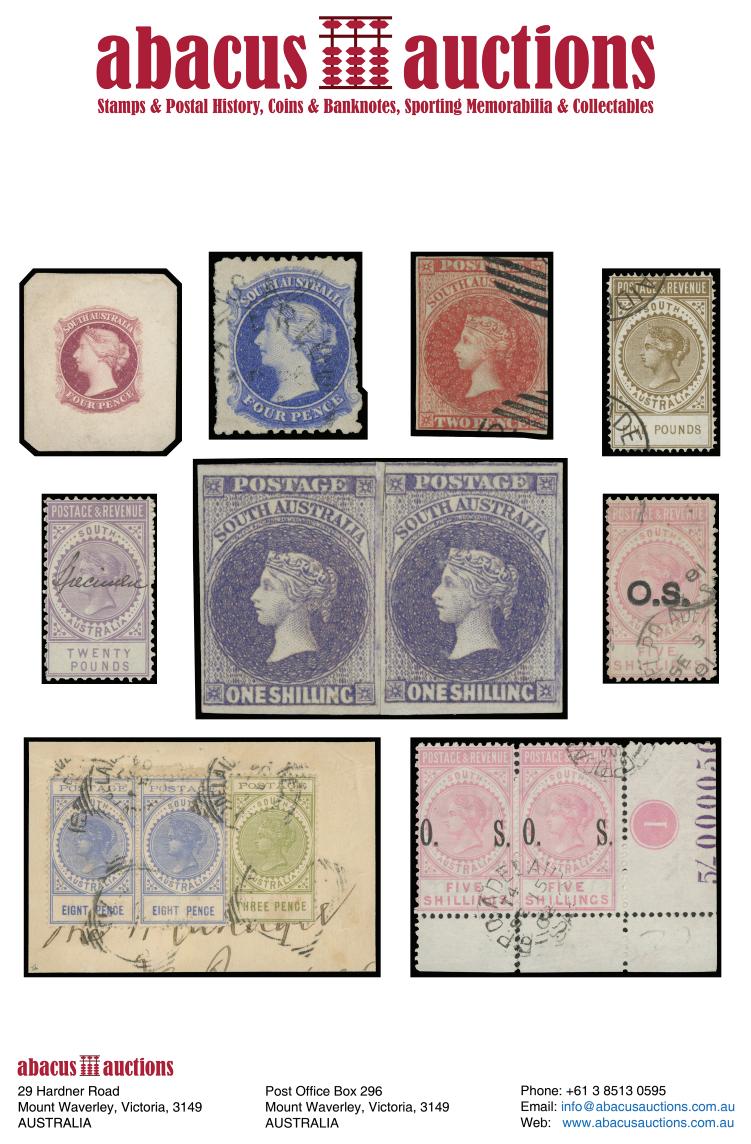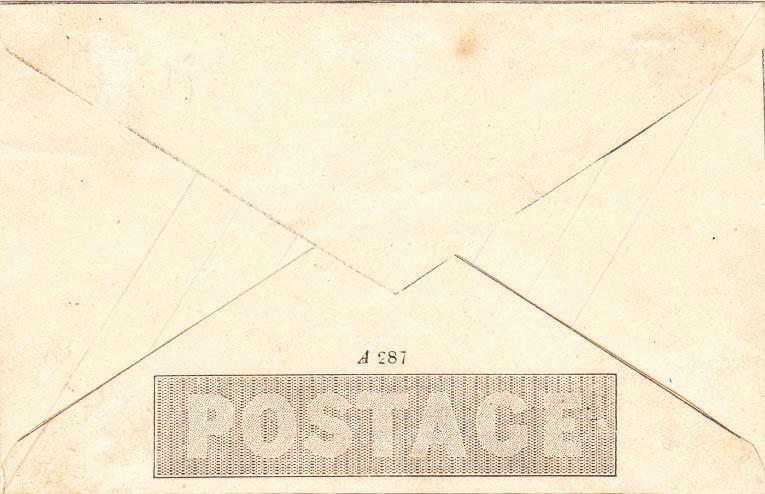
14 minute read
The Mulready: Conception to Destruction by Thomas Slemons, FRPSL
The Mulready: Conception to Destruction
Thomas Slemons, FRPSL
Advertisement
Prior to May 6,1840, the majority of correspondence was business or legal. The cost of sending a lett er was very high and the procedure complicated. Ordinary persons rarely sent personal lett ers.
Rowland Hill began the period of postal reform in 1837. It took more than three years to realize the Uniform Penny Post (UPP) which included the creation of adhesive postage stamps and postal stationery. The stamps were to be affi xed to the front of a lett er writt en on ordinary stationery. Postal stationery was to be printed in two denominations, one penny and two pence. The one-penny rate was for weight up to one half ounce and the two pence was for weight more than one half ounce up to one ounce. Each rate came in two forms: a lett er sheet and an envelope. Prior to this, envelopes were rarely used. A part of the calculation of the postage rate for a lett er was based on the number of sheets of paper. An envelope was considered a sheet of paper and increased the cost for the lett er. Another aspect considered was increased effi ciency within the postal system. Prior to the creation of the Uniform Penny Post, a lett er could be sent prepaid or unpaid at the same rate. Mistrust of the post offi ce to deliver a lett er was a factor in sending the majority of lett ers unpaid, knowing the addressee would pay for the lett er on delivery. To eliminate this ineffi ciency and provide more fi scal control, the goal was to have lett ers sent prepaid. To discourage sending a lett er unpaid, which was still allowed, a double rate was charged for the unpaid lett er. Additionally, a lett er that was sent and exceeded one half ounce or one ounce, a penalty was charged of double the defi ciency. These considerations dictated the stationery have its value printed on it.
While all factors seemed simple, the journey to fi nal production was confronted with numerous impediments. The fi rst was protests by stationers that the government was printing stationery and would harm their livelihood. A sheet of writing paper cost about a quarter of a penny – a farthing – at a stationery shop. To solve this issue, it was decided to add a farthing to the cost of the postal stationery. Security was the next area of major concern. The paper to be used had to be made in such a way as to prevent forgery. The value of a penny at that time was signifi cant and they did not want a print shop producing forged postal stationery. A producer of quality security paper was selected, and the paper had cloth threads imbedded in it. These threads were erroneously described as “silk” for many years; later research found them to be cott on. As the concepts for production continued, two further security issues were debated: further prevention of forgery beyond the use of security paper and prevention of fraudulent reuse. These issues will be discussed later.
From the artists considered to illustrate the front of the postal stationery, William Mulready was chosen. Other than showing the postage value, what was to be added was up to Mulready. He was privy to many conversations and saw much in print about the value and benefi ts of cheap postage. The benefi ts presented to him were translated into visual images expressing these concepts.
300 September-October 2022 www.collectorsclub.org
Mulready’s artwork was accepted, as it depicted the desired message presenting the benefi ts of cheap postage to both businesses and the general public.
Final debates returned to security and prevention of fraud. The fi rst of the two fi nal security measures was to have a diff erent identifying number printed on each piece of stationery. This would make counterfeiting more diffi cult and enable postmasters to recognize a forgery, if they saw the same number passing through their hands repeatedly.
The same time these steps were being done with postal stationery, the postage stamps were being developed with their own security features. The fi nal aspect of the entire system was to develop a canceling or obliterating device for both stamps and stationery. The accepted design is what is now known as a Maltese cross. Every post town was supplied with a Maltese cross canceler. Lett ers paid with postage stamps were to have the stamps affi xed to the upperright corner and struck with the Maltese cross. The fi nal security measure relating to the stationery can only be described as approaching absurdity. To prevent fraudulent reuse of stationery, postmasters were instructed to cancel the stationery in the center of the fi gure of Britannia, part of Mulready’s design. The absurdity of this security measure was to alert a postmaster who was presented with a piece of stationery with a stamp affi xed over the center of Britannia that this might be an att empt of fraudulent reuse. Somehow the previous address and cancellations would have to have been removed for this to have succeeded.
Figure 1. The back of a Mulready envelope showing the security threads that were imbedded into the paper and the Stereo number, A 287, which was, again, to prevent counterfeiting.
Keep up to date with what’s happening in your club: www.collectorsclub.org
Collectors Club Philatelist Volume 101, Number 5 301
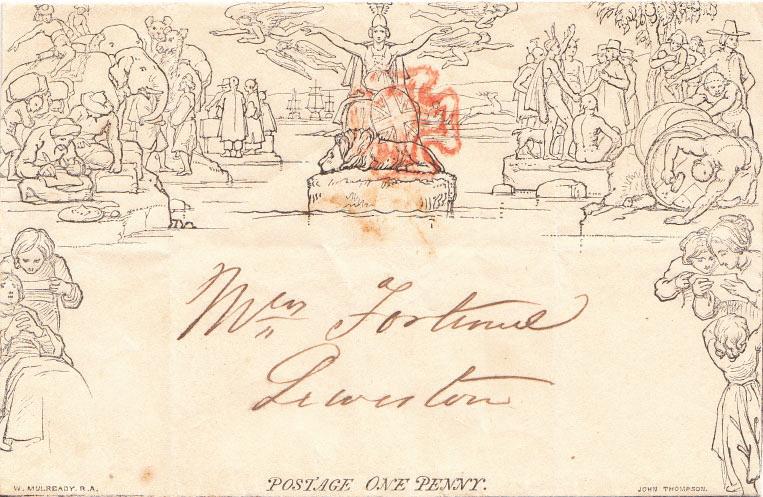
Figure 2. A Mulready canceled by a red Maltese cross directly on the fi gure of Britannia as directed to prevent fraudulent reuse.
Simultaneously, with the development of stamps and stationery, the system to handle the increased volume of mail resulting from the cheap postage was also being evaluated and enlarged. Every post town was required, on three diff erent occasions, to report the volume of mail it handled in a week. Based on these reports, it was decided that the system could operate with the projected increase in mail. In every county there was an individual known as a stamp distributor. Each of these had, as required, sub distributors. These distributors were part of Inland Revenue and dealt in revenue stamps and with no connection to the postal system. To ensure maximum availability of stamps and stationery to the public, distributors were brought into the postal system and, when available, were to begin selling postage stamps and postal stationery.
During the period when stamps and stationery were being developed and prepared for distribution, it was decided to send a one-month supply of all stamps and stationery to every post town and stamp distributor. This included a similar one-month supply for the sub post offi ces and sub distributors. Accounts were established for each of these entities and the value of all stamps and stationery to be sent was the starting point for each account. On the close of business on the fi fth of each month, all reported their sales of 1d and 2d stamps and 1d and 2d envelopes and lett er sheets, sent payment for the total sold and ordered what they anticipated needing for the following month.
In the last week of April 1840, all shipments were prepared and shipped to arrive throughout the country by May 1, 1840. All items were to be available for the public to purchase on May 1, but not valid for postage until May 6.
There was wide publicity available about the stamps and stationery, but there was no prerelease of information about the design on the envelopes and lett er sheets. There is no recorded praise or admiration of the design. Here is the design and its meaning.
302 September-October 2022 www.collectorsclub.org
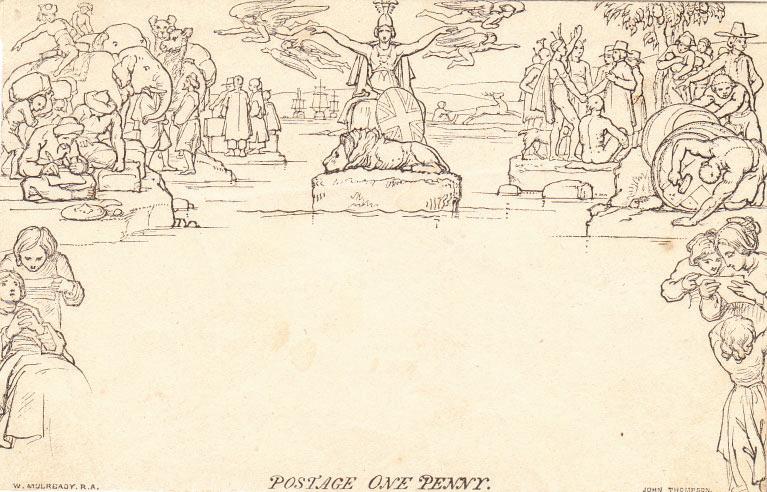
Figure 3. Top Center: Britannia sending her messengers to all parts of the world. Top Left: Trade with Asia from the West to the East. Top Right: Trade with the West Indies and the United States. Lower Left: A lett er bringing comfort to those in their sick beds. Lower Right: A lett er from an absent father to his wife and children
What followed within a few days, on May 12, was Rowland Hill’s comment in his diary: “I fear we shall be obliged to substitute some other stamp for that designed by Mulready, which is abused and ridiculed on all sides.” Note that Hill used the word “substitute,” not withdraw. Maj. E.B. Evans, a famous philatelist of his time, in his book of 1891, The Mulready Envelope, fed the misconception of withdrawal by stating, “within a week its withdrawal, in favour of something more commonplace, was recognized as necessary.” The statements of Hill and Evans were so misinterpreted, they became “fact” that Mulreadys were withdrawn soon after May 1840. Nothing could be further from the truth. Work on a substitute for the Mulready began and was fi nally released to the public in London on Feb. 10, 1841, known as The Penny Pink.
Collectors Club Philatelist
Time proven Showgard® Mounts...
–Showgard Mounts are the choice and recommendation of experienced collectors. –For over 25 years Showgard Mounts have proven perfectly safe for stamps under every climatic condition in all parts of the world. –It is a philatelic fact that collectors switch to Showgard Mounts as they gain in experience. It’s a sensible idea to start and save with Showgard Mounts. At dealers everywhere. Available with Dark Display or clear see-through background.
For Free Sample and Size Gauge Please Write VIDIFORMS CO. INC.
Showgard House 115 North Route 9W Congers, NY 10920
Volume 101, Number 5 303
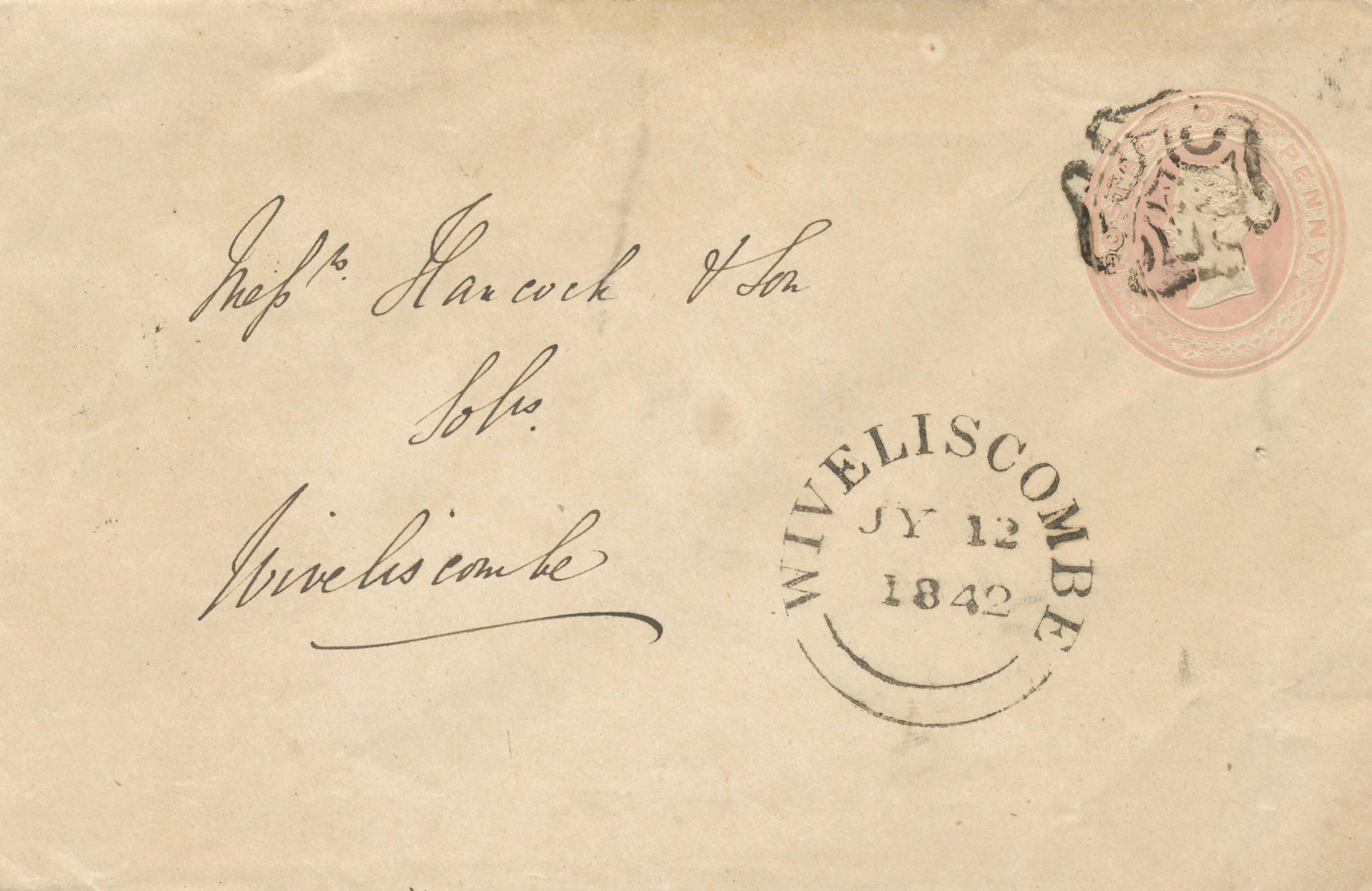
Figure 4. The Penny Pink envelope, the replacement for the Mulready stationery, released Feb. 10, 1841. The Penny Pink lett er sheets were not created at the same time. They were released on April 18, 1844.
Figure 5. A Mulready advertisement from a fi rm in London containing multiple advertisements. The number of Mulreadys required to produce the quantity promised would have had to have come from Somerset House, which held stocks to fi ll the order.
The size of supplies of Mulreadys sent to post offi ces in the initial distribution varied and was based on estimated monthly use. At the close of business on June 5, 1840, and on all subsequent months, postmasters completed monthly reports of sales of all stamps and stationery and paid for items sold. At the same time, they estimated their sales of all items for the next month and ordered the quantity of each necessary as a part of their end-of-month report. Thus, if Mulreadys were not being sold, there was no need to order more. As time passed and Penny Pinks were available, they were ordered instead of Mulreadys.
The unexpected demand for Mulreadys came from the business sector of the economy. Printers, booksellers and stationers were quick to recognize a profi t potential, selling their own products, services and advertising for other businesses. After printing advertisements on the inside, much like the newspaper classifi ed ads of today, they were able to sell the Mulreadys to the public at a heavily discounted price – as litt le as 9d per dozen, versus the post offi ce price of 15d per dozen. Individual businesses followed with advertising for themselves. This was the birth of what we now term “junk mail.”
Banks soon followed, using Mulready envelopes, then transitioning to the more practical lett er sheets. By December 1840, insurance companies saw the potential for advertising and one company off ered to have its agents’ names and particulars printed inside and sell them to their agents at a discounted price of
304 September-October 2022 www.collectorsclub.org
10d per dozen. The latest large volume users of Mulreadys were the tax offi ces, mainly in Scotland, in 1841 and 1842, which ended with the withdrawal of stocks.
In the case of stamp distributors, initial supplies sent were much greater, as they were seen as suppliers of much larger quantities than any one-month supply sent to postmasters. When looking at promised sales of Mulready lett er sheets produced by advertisers, that demand for Mulreadys to be used for printed advertisements, far exceeded the number that any post offi ce would have had on hand as stock. Purchasers of large quantities had an option of purchasing from stamp distributors or directly from Somerset House in London.
In late November 1840, it was belatedly observed that Mulreadys were not selling to the general public and the decision was made to stop printing them. The existing stock on hand was judged to be adequate to meet projected needs. A bit later they realized that there was a large stock of the security-threaded paper still on hand, but no use for it. The decision was made to use it to produce the Penny Pink envelopes. Some early production envelopes have security threads, but these disappeared after the supply of Mulready paper was exhausted.
On Nov. 15, 1842, at a meeting of Inland Revenue, withdrawal of the stocks of Mulreadys was discussed. It was decided to begin the withdrawal of stocks from stamp distributors. It was also decided to prepare a notice, instructing the withdrawal, but not to send it to all instructing the with distributors at one time. The notice was sent distributors at gradually, lest they be overwhelmed with the gradually, quantity returned. quantity
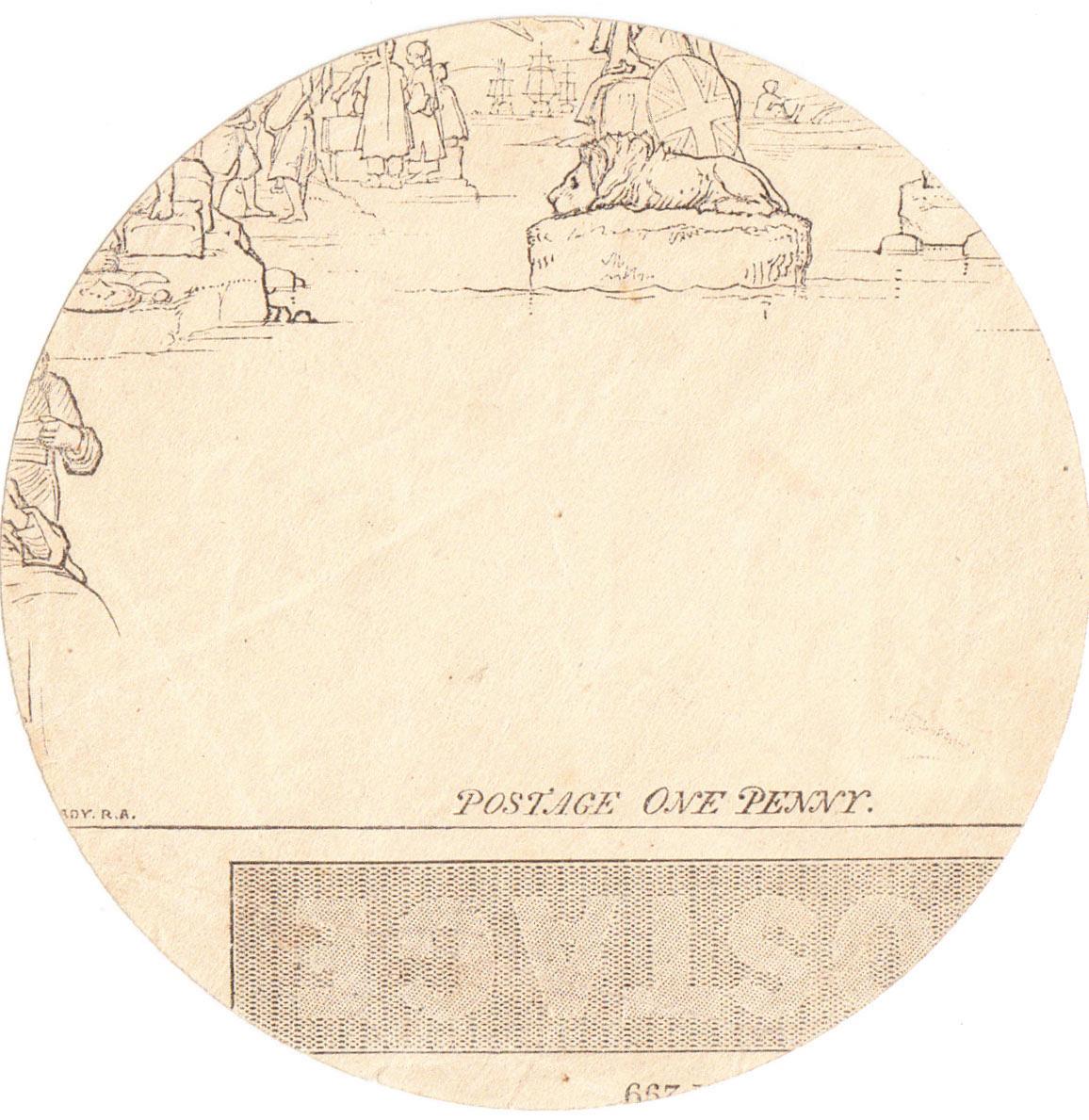

Figure 6 (above). The front of the Mulready shows that punch has removed the value and the Stereo A 299 shows. Right: The back of the destroyed Mulready envelope with the annotation. The identity of the initials is unknown.

Collectors Club Philatelist Volume 101, Number 5 305
On Dec. 2, 1842, Inland Revenue received the fi rst document of return of stocks from Mr. Humphrey of Sudbury, Suff olk, the head stamp distributor for the County of Suff olk. It stated, “I have returned the stock of old postage covers and envelopes by wagon.” These returns of stock took several years. No such requirement for postmasters to return their stock exists in offi cial documents.
Below: Full formes of the Mulready lett ersheet and Mulready envelope.
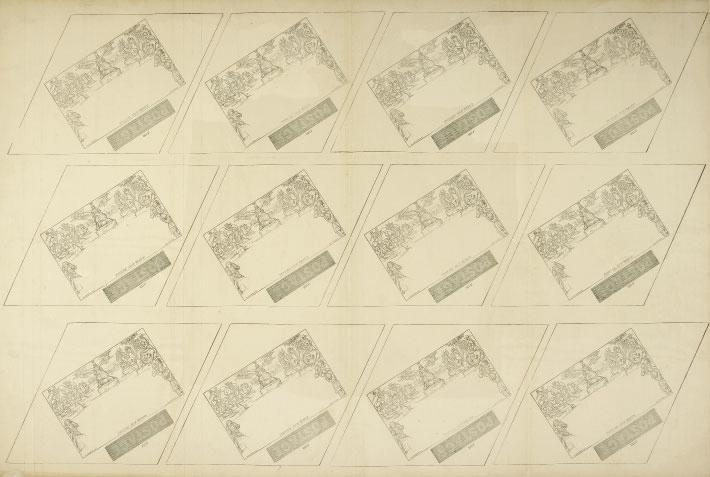
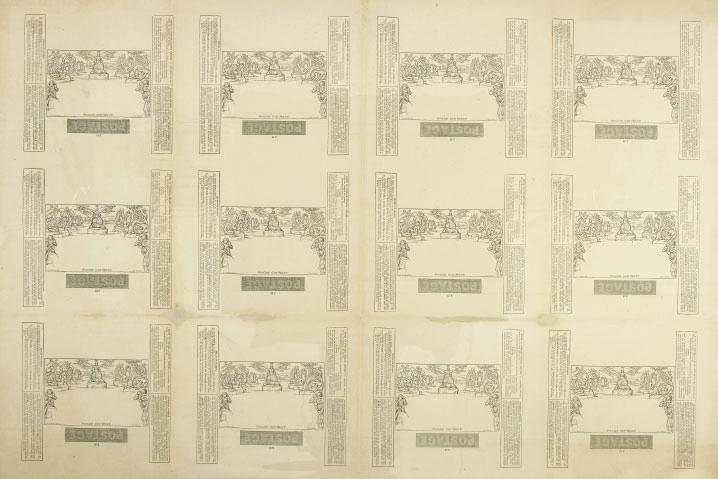
306 September-October 2022 www.collectorsclub.org
Time and normal use had dwindled those stocks. Normal use of Mulreadys, excluding advertisements, is rarely seen after late 1844.
The next problem faced was how to destroy the massive amount of returned stock. The fi rst eff ort, burning them in furnaces, proved impractical. It has been reported that a machine was constructed to destroy them. No patent or factual description of the machine has been found. An article in 1982 described a circular disc had been found that had been punched from the center of a Mulready envelope. Many years later, the disc appeared for sale and is seen in Figure 6 with a notation on the back. The punch that destroyed the envelope removed the value, one penny, thus demonetizing it. A similar two-penny envelope has been discovered in the Cole papers that are held in the Victoria and Albert Museum in London. Looking at the layout of the formes Mulready lett er sheets and the distinct diff erence of the formes of Mulready envelopes, demonstrates that the machine had a movable punch or punches to position it or them to punch out the center precisely. It was probably hydraulically operated to punch through stacks of formes of Mulreadys. In the case of the one-penny disc, it is from a second series envelope. This makes sense in that the Second Series envelopes had very litt le distribution and would have been in the remaining stock at Somerset House. The disc is the only example recorded in private hands.
Inland Revenue documents confi rm the massive amount of destroyed Mulreadys was sold to a paper mill, recycled into pulp and thus retuned to life in a new form of paper.
About the Author
Thomas Slemons created the numbering and descriptions of the Mulready advertisements as listed in the Stanley Gibbons Queen Victoria, Volume 1, Part 1, 1st Edition of the Great Britain Specialised Stamp Catalogue.
He is currently writing a book about the Mulready and its advertisements. If anyone can add to what is contained in this article or any new advertisement not listed in the Stanley Gibbons catalog, it is welcome.
Slemons would like to receive scans of any Mulready advertisement. Please scan at 300dpi or bett er, fully opened, the front as well as the advertisement, so that origins, dates and destinations can be recorded. These will be included in a census of all recorded uses of the advertisements. Contact information: Thomas.Slemons@gmail.com, Thomas Slemons, 1410 Timber Trl, Greenwood IN 46142-1143.
Don’t forget!
Our library is a great member resource! Online CCNY Library information is available:
www.collectorsclub.org/the-collectors-club-library/
Collectors Club Philatelist Volume 101, Number 5 307
308 September-October 2022 www.collectorsclub.org
